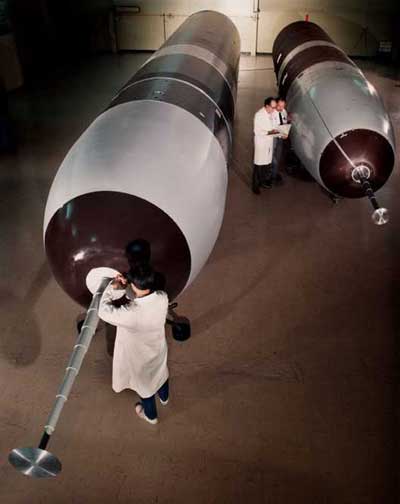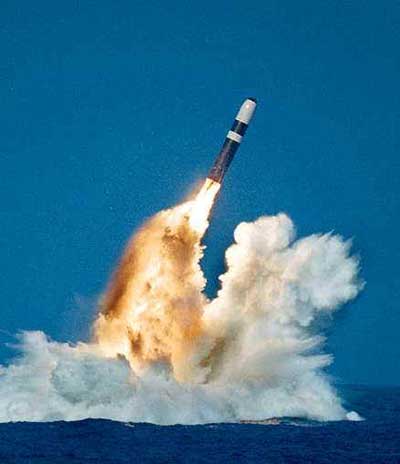Lockheed UGM-96A Trident I C4/UGM-113A
Trident II D5 


| Trident I C4 | Trident II D5 | |
| Type | tretrins ubådsaffyret ballistisk missil | tretrins ubådsaffyret ballistisk missil |
| Diameter | 1,88 m | 2,11 m |
| Længde | 10,36 m | 13,41 m; 13,96 m |
| Vægt | 33.133 kg | 58.500 kg |
| Sprænghoved | 8 100 KT W76 nukleare sprænghoveder fremført i 8 Mk 4 MIRV | 8-14 MIRV hver med et 375 KT sprænghoved |
| Motorer | ||
| Rækkevidde | 6.810 km | 7.360-11.100 km (12.000 km) |
| CEP | 547 m | 92,5 m |
| I tjeneste | 1979 | 1990 |
Storbritannien
- 4 Vanguard-klassen SSBN: 16 Trident 2 (D5)
USA
- 18 Ohio-klassen SSBN
Formålet med udviklingen af Lockheed UGM-96A Trident I C4 missilprogrammet var essentielt at forøge rækkevidden for amerikanske SLBMer for at tillade brugen af større og mere afsides patruljeområder. Trident I er et tretrinsmissil med fast brændstof som blev testaffyret i 1977 og blev operationelt to år senere ombord på ombyggede SSBN af Benjamin Franklin- og Lafayette-klasserne. Missilets første to trin er essentielt de samme som på det tidligere Poseidon C3 SLBM, men det tredje trin er forsynet med stjerne-inertialstyring for at give den krævede præcision over den større rækkevidde. De første 8 Ohio-klassen SSBN blev udrustet til at medføre Trident I, men disse blev senere ombygget til Trident II med endnu større rækkevidde i begyndelsen af 1990'erne.
Varianter:
UGM-96A Trident I C4: indført i 1979 som den primære bevæbning
for Ohio-klassen SSBN men også medført på et
antal ombyggede Benjamin Franklin og Lafayette-klassen SSBN.
Tident I er essentielt Poseidon SLBM med et tredje trin til forøget
rækkevidde og et meget mere avanceret sprænghoved baseret på
Mk 4 MIRV
Trident Fleet Ballistic Missile
Description: Intercontinental ballistic missiles launched from submarines.
Background: Submarine launched ballistic missiles (SLBMs) have been an integral part of the strategic deterrent for six generations, starting in l956 with the U.S. Navy Fleet Ballistic Missile (FBM) Polaris (A1) program. Since then, the SLBM has evolved through Polaris (A2), Polaris (A3), Poseidon (C3) and today’s force of Trident I (C4) and Trident II (D5). Each generation has been continuously deployed at sea as a survivable retaliatory force and has been routinely operationally tested and evaluated to maintain confidence and credibility in the deterrent.
Trident I (C4) was first deployed in 1979 and is planned to be deployed until phased out in the early 2000s. Trident II (D5) was first deployed in 1990 and is planned to be deployed past 2020. The Trident II (D5) missile is also provided to the United Kingdom which equips the missile with UK warheads and deploys the missile on Vanguard Class UK submarines.
Features: Trident I (C4) and Trident II (D5) missiles are deployed in Ohio- class (Trident) submarines, each carrying 24 missiles.
The Trident II (D5) is a three-stage, solid-propellant, inertially guided FBM with a range of more than 4,000 nautical miles (4,600 statute miles). Trident II is more sophisticated than Trident I (C4) with a significantly greater payload capability. All three stages of the Trident II are made of lighter, stronger, stiffer graphite epoxy, whose integrated structure means considerable weight saving. The missile’s range is increased by the aerospike, a telescoping outward extension that reduces frontal drag by about 50 percent. Trident II is launched by the pressure of expanding gas within the launch tube. When the missile attains sufficient distance from the submarine, the first stage motor ignites, the aerospike extends and the boost stage begins. Within about two minutes, after the third stage motor kicks in, the missile is traveling in excess of 20,000 feet (6,096 meters) per second.
General Characteristics, Trident I (C4)
Primary Function: Strategic Nuclear Deterrence
Contractor: Lockheed Martin Missiles and Space, Sunnyvale, Calif.
Propulsion: Three-stage solid-propellant rocket
Length: 34 feet (10.2 meters)
Weight: 73,000 pounds (33,142 kg)
Diameter: 74 inches (1.8 meters)
Range: 4,000 nautical miles (4,600 statute miles or 7,360 km)
Guidance System: Inertial
Warhead: Nuclear MIRV (Multiple Independently Targetable Reentry Vehicles)
Date Deployed: 1979
General Characteristics, Trident II (D5)
Primary Function: Strategic Nuclear Deterrence
Contractor: Lockheed Missiles and Space Co., Inc., Sunnyvale, Calif.
Unit Cost: $30.9 million
Power Plant: Three-stage solid-propellant rocket
Length: 44 feet (13.41 meters)
Weight: 130,000 pounds (58,500 kg)
Diameter: 83 inches (2.11 meters)
Range: Greater than 4,000 nautical miles (4,600 statute miles, or 7,360
km)
Guidance System: Inertial
Warheads: Nuclear MIRV (Multiple Independently Targetable re-entry
Vehicle); Maneuverable Re-entry Vehicle
Date Deployed: 1990